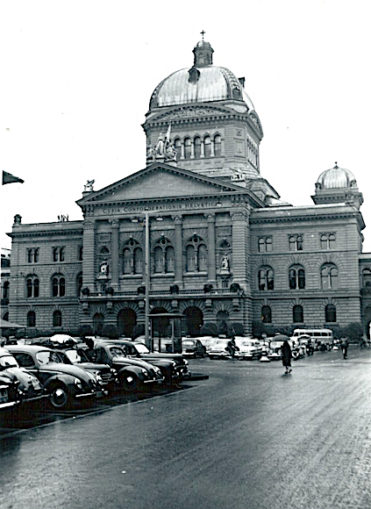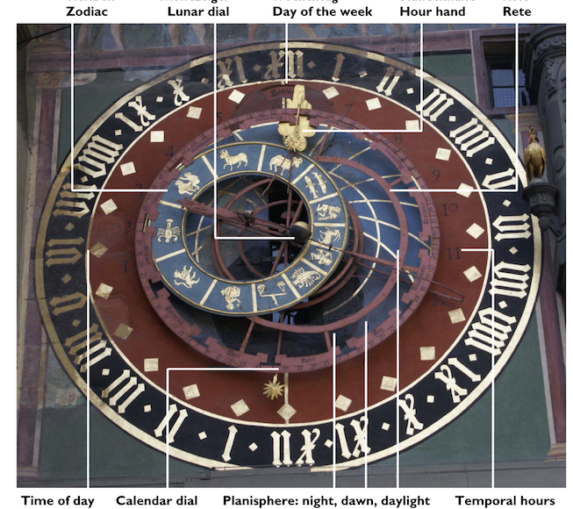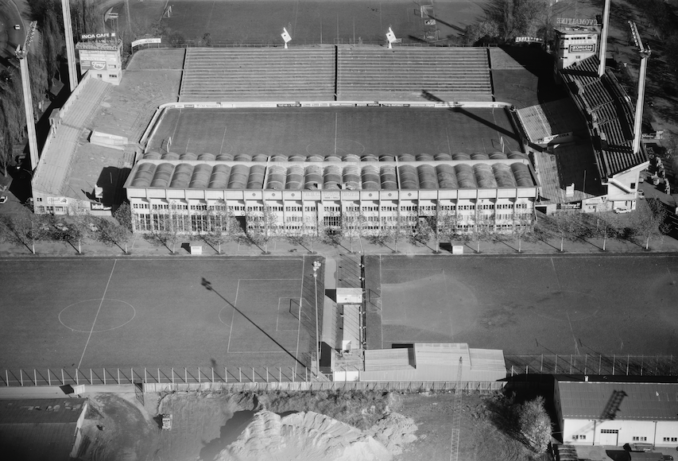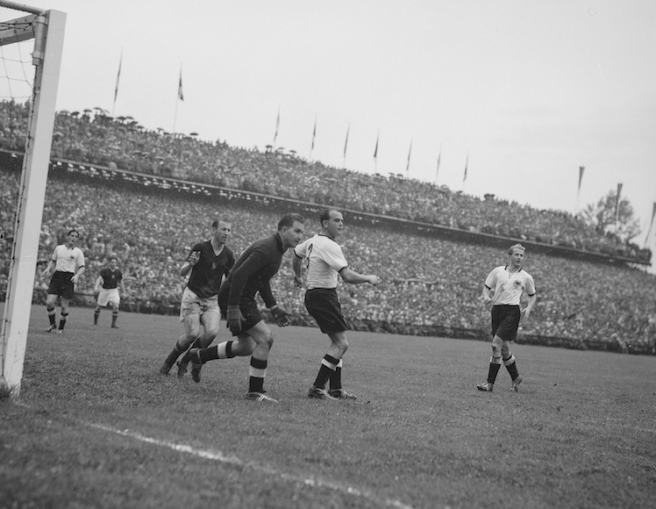
© Always Worth Saying 2022, Going Postal
Berne is the capital of Switzerland and enjoys a modern-day population of about 130,000. The old part of the city is contained within a bend in the river Aare which, along this part of its course, runs between lakes Thunersee and Wohlenzee. To the west, landside of the bend, the old town ends at another disappointing Swiss rail terminus. Arched train sheds protect the platforms from an Alpine climate which alternatively batters and bleaches a dull modern concrete block containing the Bahnhalle.
Our first photograph is captioned the ‘Federal Palace, Berne’, which sits in the southern part of the old town. Taken on a wet day during my grandparent’s 1954 road trip in their Ford Prefect, a lady in a black coat shelters beneath an umbrella.
It is still possible to stand on about the same spot (where Barenplatz reaches Bundezplatz). Although Barenplatz is still marked on the map for parking it sometimes hosts a public market. As for Bundespalz, the parked cars have gone and are replaced by an open place and one of those fountains that irritate straight out of the pavement in numerous spouts. In winter, part of the platz is also used for ice skating. Beyond that, the actual frontage of the parliament building remains unchanged.
© Always Worth Saying 2022, Going Postal
The tower pictured above is the Zytglogge or ‘time bell’. The medieval tower built in the early 13th century has served as a guard tower, prison, clock tower, centre of urban life (does that mean town hall?) and civic memorial. Said to be the oldest monument in the city, and a significant part of the UNESCO Old City of Berne World Heritage site, the clock face is a 15th-century addition.
The unconventional lower face, immediately above the road arch, is an astronomical clock depicting days of the week, a lunar cycle, the zodiac sign, a calendar and an indication of timings for dawn, daylight and night. The temporal hours are displayed on a much larger dial above. Too complicated for me to understand, cleverer Puffins than I might be able to make sense of it from the Wikipedia image reproduced below. (What does rete mean?). Let’s not forget the Swiss are the race who reduced their entire railway system and timetable to one ‘easy-to-understand’ graphic with half the stations missing.

Zytglogge tower in Bern, Switzerland,
Sandstein – Public domain
As we reach the more populous parts of Switzerland, capable of forming a crowd, and since its two weeks since the last mention of a World Cup wendyball match, I feel it safe to recall that during this 1954 visit the World Cup was being held in Switzerland.
Firstly we must apologise to Lugano which we visited a few weeks previously as a World Cup match was held there. A crowd of 26,000, no doubt swelled by Italians from the other side of the nearby border, gathered to watch Italy play Belgium. The Azzuri led one nil at halftime and extended their lead to four clear goals in the second half before Anoul scored a consolation for Belgium with 9 minutes to go.
The game was played at the Cornaredo Stadium which was originally built in 1951 with a capacity of 15,000, 5,000 of whom were seated along one side and 10,000 of whom stood on terracing around the remaining three-quarters of a pitch bounded by an athletics track. Unusually the curved ends weren’t curves but angled straight terracing which headed back toward the corner flag in a straight line upon reaching the goalposts. These days the capacity is reduced to 6,300 with a newer stand having been built opposite the old one on the tunnel side. Lugano still play there in the Swiss Super League but following bankruptcy in 2008 are a different legal entity than the original 1908 club.
Berne hosted five matches, the first of which was the opening game between Uruguay and Czechoslovakia back in the days when the holders started off the tournament rather than whoever happened to be the Sultan of Qatar’s choice.
The stadium used was the Wankdorf, home of Young Boys Berne. Originally opened in 1925 with a capacity of 22,000, over the decades it was expanded piecemeal then demolished and rebuilt allowing for an impressive 62,500 capacity in anticipation of the World Cup matches.
Up and over stands, terracing, benches, an arched cantilever roof along one side, clock towers in two corners and massive concrete floodlight pylon porn made the Wankdorf a distinctive period piece sadly replaced by an all-seated tin box for the 2008 Euros.
The WC Wannkdorf also boasted sloped areas as well as stepped terracing, like the tarmac at Gigg Lane in the 1970s. Where there was conventional terracing, the steps were wide enough to allow five rows of people to stand on each step – but only the front one or two could see anything other than the backs of heads. With a current capacity of 32,000, even the name hasn’t survived with the ground now being known as Stade de Swiss.

Bern stadt 1970,
Werner Friedli – Licence CC BY-SA 4.0
So where did that original distinctive name come from? As every Puffin knows, dorf means village in German and wank, perhaps unsurprisingly, literally means wobble. However, wang means a green meadow, therefore we shall assume the Wankdorf area of Berne to have originally been named when still a hilly meadow outside of the old walled city.
The group stage of the 1954 World Cup was competed for in an odd format. Not all the teams played each other but rather the two unseeded countries in each group played the two seeded. The logic being unseeded teams could earn a place in the quarter-finals by beating one or two of the seeded nations.
Being a relatively small country with its big cities close together, teams weren’t hosted by a particular ground. As well as the Group 3 opening match (a 2-0 win for Uruguay), the Wankdorf hosted Group 2’s Berlin to Baghdad derby between West Germany and Turkey (4-2), and England’s 2-0 Group 4 win over the Swiss hosts, with Wolverhampton Wanderers duo Dennis Wilshaw and James Mullen scoring in front of a 43,119 crowd.
Hungary versus Brazil was the quarter-final match played in Berne, 4-2 to the Europeans who were that Golden Team of Mighty Magyars which included legends such as Puskas, Kocsis, Hidegkuti and Czibor. Between 1950 and 1956, Hungary played 69 internationals, winning 58, drawing 10 and losing only one. Those 58 victories included a 7-1 thumping of England at Budapest’s Nepp Stadium and a ‘Match of the Century’ 6-3 win at Wembley, England’s first home loss to a side from outside of the British Isles.
The Wankdorf match earned a moniker too as q ‘Battle of Berne’ officiated over by English referee Arthur Ellis who was forced to send off three players during the ninety minutes.
In driving rain and on a slippery pitch the South Americans saw the red mist partway through the second half when Hungary were awarded a penalty. A pitch invasion followed – of Brazilian journalists and gentlemen in suits from the Brazilian FA. After having been removed from the pitch by the police, Lantos converted from the spot after which the match degenerated further with Bozsik and Santos sent off for fighting and Tozzi sent off for kicking Lorant. As well as the sendings off, the towsy ninety minutes included 42 free kicks, 2 penalties, four cautions and four stitches in a head wound sustained by Hungarian manager Gusztav Sebes. After the final whistle, fighting continued in the dressing rooms and didn’t end until the Hungarian’s security detachment, presumably there to stop the Cold War Magyars from defecting to the West, drew their guns and used their batons on the over-excited Latins. Lads.

Fussball-Weltmeisterschaft 1954,
Unknown photographer – Licence CC BY-SA 4.0
In his 1962 biography, referee Ellis blamed politics and religion, concluding the clash to be between Communist Hungarians and Catholic Brazilians. “It was a disgrace,” he wrote, “It was a horrible match. Certainly British players and fans would never act in such a most reprehensible manner.” More innocent times this side of the Channel.
Also in that round, despite goals from legends Tom Finney and Nat Lofthouse, England lost to World Cup holders Uraguay 4-2. Puffins of a certain age got to meet these people, or at least to be rude to them on the telephone. Finney retired from football to become a Preston plumber. A bit pleased with himself, over the phone he would always introduce himself as Tom Finney rather than the plumber. Building sites across the north of England were under strict instruction to reply “Who?”
Nat Lofthouse once did the half-time draw atop the impressive camber at Burnden Park during a bitingly cold Bolton Christmas fixture while a young Worth-Saying was shivering in the away end.
Back in the 1954 Swiss World Cup, the semifinals were played in Basel and Lausanne respectively with the tournament culminating in Berne with a final between much fancied Hungary and under-dogs West Germany.
In another notable encounter, nicknamed the ‘Miracle of Berne’, Hungary’s Golden Team lost to the unfancied West Germans despite being two goals up after 8 minutes through strikes from Puskas and Czibor. Morlock pulled one back for the Federal Republic as early as the 10th minute. Rahn equalised eight minutes later and scored the winner six minutes from time with a low hard drive past Hungarian keeper Grosics and in doing do inflicted the opposition’s only defeat in those 69 games between 1950 and 1956.
© Always Worth Saying 2022


